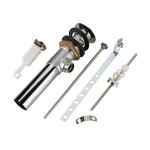How to Fix Sinking Couch Cushions
Sinking couch cushions are a common household predicament, often indicating wear and tear on a beloved piece of furniture. A comfortable and supportive couch is essential for relaxation and overall home enjoyment. When cushions begin to sag and lose their form, it detracts from both the aesthetic appeal and the functional comfort of the seating arrangement. Addressing this issue can rejuvenate your couch, prolong its lifespan, and restore optimal comfort. This article provides a detailed guide to diagnosing the causes of sinking couch cushions and offers various methods for effective restoration.
Several factors contribute to the degradation of couch cushions. Over time, the internal components, such as foam, batting, or springs, undergo compression and displacement due to repeated use and weight distribution. The fabric encasing the cushion can also stretch or weaken, exacerbating the sinking effect. Understanding these underlying causes is crucial for selecting the appropriate repair strategy and achieving lasting results.
Identifying the Cause of the Sagging
Before embarking on any repairs, it's imperative to accurately identify the root cause of the sinking cushions. This involves a thorough inspection of the cushion's internal structure and external covering. Examine the fabric for signs of stretching, tearing, or thinning. If the fabric is significantly worn, it may require replacement alongside other repairs.
Next, assess the condition of the internal filling. Common materials used in couch cushions include polyurethane foam, down feathers, fiberfill (batting), and innerspring units. Each material has a different lifespan and susceptibility to compression. Polyurethane foam, for instance, can gradually lose its density and resilience over time, leading to a flattened and unsupportive cushion. Down feathers, while luxurious, can shift and clump together, causing uneven weight distribution and sinking.
Fiberfill, a synthetic material composed of polyester fibers, is often used as a more affordable alternative to down. However, fiberfill can flatten and compress more quickly than foam or down, particularly with heavy use. Innerspring cushions, while less common in modern couches, may suffer from broken or weakened springs, resulting in localized sinking.
To assess the internal filling, gently compress the cushion in various areas. Feel for any areas that are noticeably softer or less supportive than others. If possible, unzip the cushion cover to directly inspect the filling material. Look for signs of crumbling, tearing, or excessive compression. Note the type of filling material used in your cushions, as this will influence your choice of repair methods and replacement materials.
Finally, examine the couch frame itself. A sagging frame can contribute to the appearance of sinking cushions, even if the cushions themselves are in good condition. Check for broken or weakened supports, loose joints, or damaged webbing. Addressing any structural issues with the frame is essential for providing a stable base for the cushions and preventing future sagging. Evaluate the support structure beneath the cushions. This often involves webbing or springs. If either of these are broken or significantly stretched, they need to be repaired or replaced before addressing the cushions themselves.
Methods for Repairing Sinking Couch Cushions
Once the cause of the sagging has been identified, a variety of repair methods can be employed to restore the cushions' firmness and support. The most appropriate method will depend on the type of filling material, the extent of the damage, and your budget and skill level.
Adding Filling Material: For cushions with compressed or flattened filling, adding more material can significantly improve their support. This is a relatively straightforward method that is particularly effective for cushions filled with foam, fiberfill, or down feathers.
For foam cushions, new foam inserts can be purchased from upholstery supply stores or online retailers. Choose a foam density and thickness that is appropriate for your couch and your desired level of firmness. Cut the foam to the exact size and shape of the cushion, ensuring a snug and comfortable fit. If the existing foam is only slightly compressed, a layer of high-density foam can be added on top to provide extra support. Alternatively, completely replacing the old foam with a new insert is a more comprehensive solution for severely compressed cushions.
For fiberfill cushions, additional batting can be added to restore their loft and fullness. Open the cushion cover and fluff the existing fiberfill to redistribute it evenly. Then, add new fiberfill to fill any empty spaces and create a more supportive cushion. Be careful not to overfill the cushion, as this can make it too firm and uncomfortable. Gently massage the filling to ensure it is evenly distributed and then reseal the cover.
For down-filled cushions, adding more down feathers can restore their plumpness and comfort. However, working with down feathers can be messy and require special handling. It is recommended to work in a well-ventilated area and wear a mask to avoid inhaling the feathers. Carefully open the cushion cover and add new down feathers to fill any empty spaces. Securely reseal the cover and fluff the cushion to distribute the feathers evenly.
Replacing the Cushion Inserts Entirely: In cases where the existing cushion inserts are severely damaged or beyond repair, replacing them entirely may be the most effective solution. This involves removing the old inserts and replacing them with new ones made from the same or different materials. When choosing replacement inserts, consider the type of material, the density and thickness, and your personal preferences for firmness and support. High-density foam inserts are a popular choice for their durability and support, while down-filled inserts offer a more luxurious and comfortable feel. Fiberfill inserts are a more affordable option, but they may not last as long as foam or down.
Before purchasing replacement inserts, measure the dimensions of your existing cushions to ensure a proper fit. You can either measure the old inserts directly or measure the inside dimensions of the cushion covers. When installing the new inserts, ensure they are snug and evenly distributed within the covers. This may require some manipulation and adjustments to achieve the desired shape and firmness.
Using Cushion Support Boards: For couches with a tendency to sag, cushion support boards can provide an extra layer of support and prevent the cushions from sinking. These boards are typically made from plywood or other rigid materials and are placed underneath the cushions to distribute weight evenly. Cushion support boards are a simple and affordable solution for addressing sagging couches, particularly those with weak or damaged frames. To install cushion support boards, simply measure the width and depth of the seating area and cut the boards to the appropriate size. Place the boards underneath the cushions, ensuring they are evenly distributed and securely supported. The boards should be covered with a soft material, such as felt or fabric, to prevent them from scratching or damaging the couch frame.
Preventative Measures and Ongoing Maintenance
Once the sinking couch cushions have been repaired, taking preventative measures and implementing a regular maintenance routine can help prolong their lifespan and prevent future sagging. These measures include regular fluffing, rotating cushions, and protecting from excessive wear and tear.
Regular Fluffing: Fluffing the cushions regularly helps to redistribute the filling and prevent it from settling or compressing. This is particularly important for cushions filled with down feathers or fiberfill, which are more prone to clumping. To fluff the cushions, simply lift them up and shake them vigorously, then gently pat them back into shape. Aim to fluff the cushions at least once a week, or more often if they are heavily used.
Rotating Cushions: Rotating the cushions helps to distribute wear evenly and prevent localized sagging. This involves swapping the positions of the cushions on a regular basis, such as once a month or every few months. By rotating the cushions, you can prevent certain areas from becoming excessively compressed or worn. Be sure to rotate both the seat cushions and the back cushions to ensure even wear throughout the couch.
Protecting from Excessive Wear and Tear: Protecting the couch from excessive wear and tear can significantly extend the lifespan of the cushions. This includes avoiding activities that can damage the cushions, such as jumping or standing on them. It also includes protecting the fabric from spills, stains, and fading. Use couch covers or slipcovers to protect the fabric from dirt, dust, and spills. Clean spills immediately with a soft cloth and a mild detergent. Avoid placing the couch in direct sunlight, as this can cause the fabric to fade and weaken over time. Consider using furniture polish or protectant sprays to help maintain the fabric's appearance and durability.
Professional Cleaning: Periodic professional cleaning can assist in preserving the cushions' integrity. Professional upholstery cleaning services can effectively remove dirt, stains, and allergens from the cushions, helping to keep them looking and feeling their best. Professional cleaning can also help to revitalize the filling material and prevent it from becoming compressed or matted. Depending on the type of fabric and filling material, professional cleaning may be recommended every one to two years.
By implementing these preventative measures and maintaining a regular maintenance routine, one can significantly extend the lifespan of sofa cushions and enjoy a comfortable and supportive seating arrangement for years to come. Proper care and attention can prevent future sagging and ensure that the investment in a couch is well-protected.

How To Fix Saggy Couch Cushions An Exercise In Frugality

How To Rescue Your Saggy Couch Cushions Supermom Shuffle

How To Fix Sagging Couch Cushions A That Sinks

Easy Inexpensive Saggy Couch Solutions Diy Makeover Love Of Family Home

How To Fix Sagging Couch Cushions

4 Ways To Fix Sagging Sofa Cushions Wikihow

How To Fix Sagging Couch Cushions Thistlewood Farm

How To Fix Sagging Couch Cushions Thistlewood Farm

Diy Sagging Couch Cushion Itsabradenfullife Home Improvements Carolyn S Blooming Creations

How To Stuff Saggy Couch Cushions Under 50 Thetarnishedjewelblog







